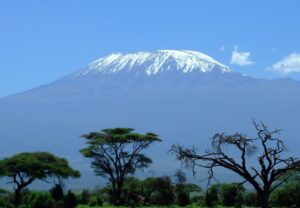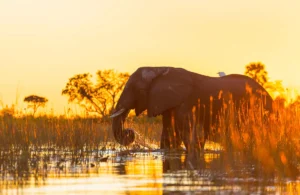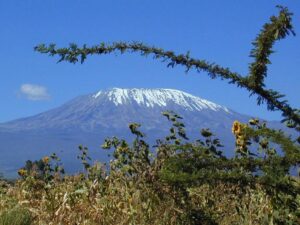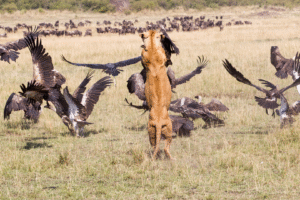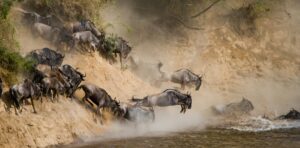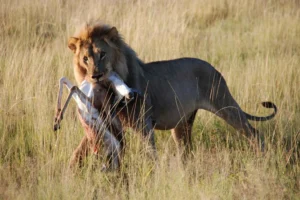Exploring the Majestic National Parks of Tanzania: A Journey into Africa’s Wild Heart
Picture standing on the edge of a vast savannah: golden hues of grass meeting as far as the eye can reach, broken only by the gliding of a giraffe or, from a distance, the roar of a lion. Welcome to the national parks of Tanzania, where the marvels of nature are not merely a sight but a feeling in every pulse beat. These parks are not mere tourist destinations; they are living theaters of the wild where every day unfolds like an epic play with the grandest of Africa’s creatures.
Tanzania boasts some of the most famous national parks in the world, including the Serengeti, Ngorongoro Crater, and Kilimanjaro National Park. These parks are almost mythical in status for the wildlife enthusiast and adventurer alike. They offer much more than mere grand scenery; they offer a feeling of being immersed in the heartbeat of the natural world. As you embark on this journey to explore the majestic national parks of Tanzania, prepare to be captivated by landscapes that have inspired countless adventurers, naturalists, and photographers.
The Iconic Serengeti: Witness the Great Migration
No review about Tanzania’s national parks would ever be complete without the Serengeti, arguably Africa’s most iconic wildlife destination. It is here that nature stages its grandest show: the Great Migration. Every year, millions of wildebeest, zebras, and gazelles move along the open plains in search of greener pastures. The raw beauty of this movement, with the predators always at hand, creates very dramatic scenes of survival, struggle, and triumph.
Visiting the Serengeti gives one a firsthand view into some of nature’s most alluring spectacles. From early morning game drives to evening safaris, one can view lions stalking their prey, cheetahs sprinting across the open plains, and elephants moving in majestic herds. Each day in the Serengeti is a lesson in patience, resilience, and fragility of beauty within the ecosystem. To many travelers, this alone speaks of their journey to the national parks of Tanzania.
Ngorongoro Crater: Exploring a Natural Wonder
Among the peculiarities of Tanzanian landscapes, the most striking one is surely the Ngorongoro Crater. More often referred to as the “Garden of Eden,” this UNESCO World Heritage Site has a very high density of wildlife one can mention rhinos, lions, and elephants among the large mammals. The crater floor, which spans over 260 square kilometers, provides a unique ecosystem where predator and prey coexist in a delicate balance.
Visiting Ngorongoro enables one to see the sights of wildlife within an encapsulated area, surrounded by dramatic geological formations. The steep sides and green floor of the crater result in a breathtakingly beautiful landscape that has always inspired naturalists through the ages. Exploring this part of Tanzania’s national parks will combine adventure, education, and awe; hence, no safari enthusiast should ever miss this destination.
Tarangire National Park: Home of the Mighty Baobabs
Tarangire National Park is much smaller than Serengeti and Ngorongoro but no less spectacular. Famous for its ancient baobab trees, Tarangire is a sanctuary to elephants, buffalo, and a wide range of bird species. Unlike the open plains of the Serengeti, Tarangire offers a more intimate safari experience through the thick forests, winding rivers, and diverse landscapes that offer yet another angle on the national parks of Tanzania.
This is most dramatic during the dry season when animals congregate along the Tarangire River, offering the best chance for photography and wildlife observation. Birdwatchers are in for a treat, too, with over 500 species recorded in the park. From morning till late evening, Tarangire gives an excellent introduction to Tanzania’s wonderfully prolific wildlife.
Ruaha National Park: Lush Swamps and Diverse Wildlife Abounds
For those seeking a more off-the-beaten-path adventure, Ruaha National Park stands out as one of the most remarkable gems among the national parks of Tanzania. As one of the largest national parks of Tanzania, Ruaha offers vast wilderness areas filled with untouched beauty and incredible biodiversity. This spectacular park, part of the national parks of Tanzania, features diverse ecosystems that range from sweeping savannahs to lush wetlands. It’s home to large populations of elephants, lions, leopards, and wild dogs, making it one of the most rewarding destinations within the national parks of Tanzania.
Ruaha is also known as a birdwatcher’s paradise, with over 570 recorded species another reason it’s celebrated among the national parks of Tanzania. Its remote location ensures fewer tourists than most national parks of Tanzania, creating a sense of solitude and pure connection with nature. For adventurers who wish to explore beyond the typical safari routes, Ruaha provides a truly wild experience that captures the essence of the national parks of Tanzania. Here, you’ll find Africa’s unspoiled wilderness and the spirit of discovery that defines the national parks of Tanzania.
Selous Game Reserve: Africa’s Largest Protected Wildlife Area
Selous Game Reserve, or Nyerere National Park, is one of Africa’s largest protected areas. This giant reserve covers more than 50,000 square kilometers and consists of a diverse range of ecosystems, including rivers, lakes, woodlands, and savannahs. Selous is renowned for its incredibly rich biodiversity, especially when it comes to large populations of elephants, hippos, and crocodiles.
As opposed to other national parks of Tanzania, Selous offers a very remote feel for safaris, including those on water, using the Rufiji River. The reserve’s size and relative isolation make it an ideal location for travelers seeking a blend of adventure, wildlife, and tranquility.
Kilimanjaro National Park: Conquer Africa’s Highest Peak
While most of the national parks of Tanzania are associated with wildlife, Kilimanjaro National Park boasts Africa’s highest mountain. This park is a magnet for trekkers and adventure lovers from different parts of the world, who come to conquer Mount Kilimanjaro. The terrain of the park varies from lush montane forests to alpine deserts and is as varied as it is breathtaking.
For those who desire less strenuous visits, walking in Kilimanjaro National Park, birdwatching, and cultural tours among the resident Chagga people are also available. This mix of adventure with a rich cultural component adds a different dimension to Tanzania’s national parks.
Mahale Mountains National Park: Chimps and Pristine Lakes
Mahale Mountains National Park is one of the more obscure of Tanzania’s national parks, offering a mix of mountain trekking, lake exploration, and chimpanzee encounters. Situated on the shores of Lake Tanganyika, Mahale is a dream come true for those who love primates: this is a place where habituated chimpanzees can be observed in their natural habitat.
The combination of lush mountains, pristine beaches, and rich wildlife in the park creates a perfect destination for those seeking peace and an immersive experience away from the crowds.
Gombe Stream National Park: Jane Goodall’s Chimpanzee Sanctuary
Gombe Stream National Park is world-renowned for Jane Goodall’s pioneering research on chimpanzees. Visitors have the rare opportunity to observe chimpanzees in the wild and learn about conservation efforts first-hand. As one of the most specialized national parks of Tanzania, Gombe provides insight into primate behavior and the critical importance of habitat preservation.
Besides chimpanzees, the park also boasts a variety of flora and fauna; the forested trails lead to a calm, educative trek.
Saadani National Park: Where the Bush Meets the Beach
Of Tanzania’s national parks, Saadani is alone in its combination of coastal and terrestrial ecosystems. Here, the bush meets the Indian Ocean, where marine and terrestrial wildlife coexists in a unique environment. Besides game drives, Saadani offers relaxation on the beach, as well as boat trips to explore mangroves and lagoons.
This park’s unique setting makes it the perfect destination for travelers in search of both wildlife adventure and beach serenity a perfect example of the diversity within Tanzania’s national parks.
Wildlife Conservation in Tanzania’s National Parks
One of the defining features of the national parks of Tanzania is their role in conservation: protecting endangered species and unique ecosystems, thereby encouraging sustainable tourism practices. Be it anti-poaching efforts in the Serengeti, community-based conservation in Ngorongoro, or research programs in Gombe Stream, each park contributes something different to the preservation of Tanzania’s natural heritage.
Travelers see not only extraordinary wildlife when visiting these parks but also support the ongoing conservation that continues to keep these landscapes alive for future generations.
Activities Beyond Game Drives
While game drives are a central feature of the national parks of Tanzania, there is so much more to explore. Many parks offer walking safaris, birdwatching excursions, cultural interactions with local communities, and photography workshops. In Kilimanjaro National Park, trekking to the summit or hiking to scenic viewpoints adds an adventure dimension beyond traditional safaris. Guided primate trekking in Mahale and Gombe Stream offers this rare chance to observe wildlife up close.
Planning Your Visit to the National Parks of Tanzania
Timing and logistics are everything on a safari to Tanzania’s national parks. Generally speaking, the dry season, from June to October, is considered the best for wildlife viewing because many animals mass around water sources. To see the Great Migration, try the Serengeti between July and October or the Masai Mara border in December.
Accommodations vary from luxurious lodges to tented camps and offer several comfort levels, all relatively close to wildlife. Working with reputable tour operators ensures safety, guided experiences, and access to the best locations within the national parks of Tanzania.
Embracing the Magic of Tanzania’s National Parks
Standing in the heart of one of Tanzania’s national parks is more than a visual experience it is transformative. Each encounter with wildlife, each walk through forests or savannah, and every sunrise over the plains leaves a lasting imprint. From the Serengeti to Saadani, from Kilimanjaro to Gombe Stream, the national parks of Tanzania offer a unique combination of adventure, education, and awe-inspiring beauty. By joining these parks, you become part of a legacy of conservation, exploration, and wonder. Tanzania’s national parks are not only sanctuaries for wildlife but also spaces where humans reconnect with the raw, unspoiled beauty of nature. Every visit contributes to sustaining these remarkable ecosystems for generations to come.
Why Tanzania’s National Parks Are Unforgettable
The national parks of Tanzania are not just destinations; they are life experiences. From the Great Migration in the Serengeti to the volcanic wonders of Ngorongoro, from hiking Kilimanjaro to the chimpanzee observatories of Mahale and Gombe, each moment spent in these parks is a story in itself. Travelers often leave with more than photographs; they leave with memories, lessons in resiliency, and a deep appreciation for the delicate balance of life in the wild. The national parks in Tanzania reflect the grandeur of the earth’s beauty, diversity, and richness, offering an adventure that is both thrilling and transformational.
Whether you are a seasoned safari-goer or visiting for the first time, Tanzania’s national parks promise experiences that will stay with you forever. Every park, every trail, and every encounter with wildlife is a reminder of the wonder of nature and the importance of protecting it. For those ready to explore, the national parks of Tanzania await an invitation to adventure, discovery, and awe.

